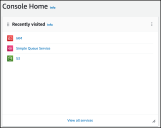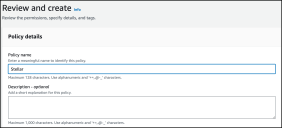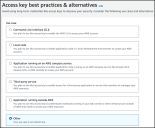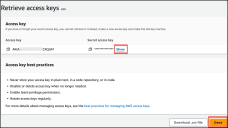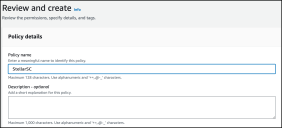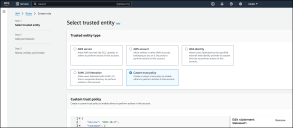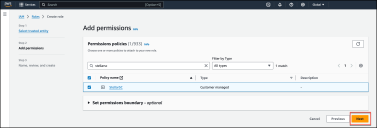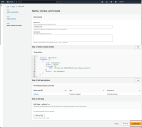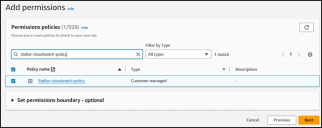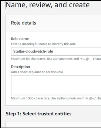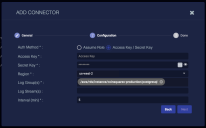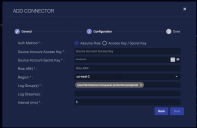Configuring AWS CloudWatch Connectors
The AWS CloudWatch connector allows Stellar Cyber to collect AWS ECS/EKS, WAF, VPC Flow, and Amazon GuardDuty logs. Use these instructions to obtain credentials and set up the connector.
Although the AWS CloudWatch connector may successfully import other logs, only AWS Elastic Container Service (ECS)/Elastic Kubernetes Service (EKS), Web Application Firewall (WAF), VPC Flow, and Amazon GuardDuty logs are supported in this release due to performance issues that can occur with other log types. Stellar Cyber is working on enhancements for other log types in future releases.
You can use an AWS CloudWatch connector to ingest logs from Amazon GuardDuty findings by exporting those logs to your AWS CloudWatch service. Refer to Amazon's documentation for configuration of this export: https://docs.aws.amazon.com/guardduty/latest/ug/guardduty_exportfindings.html .
Stellar Cyber connectors with the Collect function (collectors) may skip collecting some data when the ingestion volume is large, which potentially can lead to data loss. This can happen when the processing capacity of the collector is exceeded.
Connector Overview: AWS CloudWatch
Capabilities
-
Collect: Yes
-
Respond: No
-
Native Alerts Mapped: No
-
Runs on: DP
-
Interval: Configurable
Collected Data
|
Content Type |
Index |
Locating Records |
|---|---|---|
|
N/A |
Syslog Traffic (VPC flow) |
Domain
|
https://logs.<Region>.amazonaws.com/ where <Region> is a variable from the configuration of this connector |
Response Actions
N/A
Third Party Native Alert Integration Details
N/A
Required Credentials
-
For Access Key / Secret Key authentication: Access Key and Secret Key, plus Region, and Log Group(s)
-
For Assume Role authentication: Source Account Access Key, Source Account Secret Key, and Role ARN, plus Region, and Log Group(s)
Let us know if you find the above overview useful.
Adding an AWS CloudWatch Connector
To add an AWS CloudWatch connector:
- Add an AWS user
- Create an access key
- Identify CloudWatch log groups
- (Optional) Create an assumed role in same AWS account
- (Optional) Create an assumed role across AWS accounts
- Add the connector in Stellar Cyber
- Test the connector
- Verify ingestion
Some of the following steps require you to edit JSON-formatted data.
JavaScript Object Notation (JSON) is a lightweight data interchange format that's easy for humans to read and write, and easy for machines to parse and generate. It consists of two primary structures: a collection of name/value pairs and an ordered list of values. If you're interested in learning more about JSON, here are some useful resources:
-
For an introduction to JSON, see Introducing JSON.
-
For a basic reference, see JSON.
-
For a JSON error correction and validation tool, see JSONLint Validator and Formatter.
Adding an AWS User for Stellar Cyber

Use our example as a guideline, as you might be using a different software version.
To add a user with the appropriate permissions:
-
Log in to your AWS Management Console at https://aws.amazon.com/console. View the services in the Console Home or choose View all services.
-
Choose IAM. The IAM Dashboard appears.
-
Choose Policies and then choose Create Policy.
-
In the Create policy pane, choose the JSON tab.
-
Using the example below as a guide, edit the JSON policy document.
The following is just an EXAMPLE. You must modify this JSON to match the resources in your own environment.
CopyCloudWatch policy{
"Version": "2012-10-17",
"Statement": [
{
"Sid": "VisualEditor0",
"Effect": "Allow",
"Action": [
"logs:DescribeLogGroups",
"logs:DescribeLogStreams",
"logs:GetLogEvents",
"logs:FilterLogEvents"
],
"Resource": "*",
"Condition": {
"ForAnyValue:StringEquals": {
"aws:RequestedRegion": "us-west-2"
}
}
}
]
} To learn more about JSON, see these websites…
To learn more about JSON, see these websites…
JavaScript Object Notation (JSON) is a lightweight data interchange format that's easy for humans to read and write, and easy for machines to parse and generate. It consists of two primary structures: a collection of name/value pairs and an ordered list of values. If you're interested in learning more about JSON, here are some useful resources:
-
For an introduction to JSON, see Introducing JSON.
-
For a basic reference, see JSON.
-
For a JSON error correction and validation tool, see JSONLint Validator and Formatter.
-
-
Choose Next.
-
Give your policy a name to associate it with Stellar Cyber, then choose Create policy.
The policy can now be attached to a user.
-
From the IAM navigation pane, choose Users and then choose Create user.
-
In the Specify user details page for User details, enter a User name for the new user.
-
Choose Provide user access to the – AWS Management Console optional to produce login credentials for the new user, such as a password.
-
Choose how you want to create the Console password and then choose Next.
-
For Set permissions, choose Attach policies directly. Then search for the policy you created above.
-
Select the checkbox to the left of the policy name, then choose Next.
-
Verify the information and then choose Create user.
Creating an Access Key
For Access Key / Secret Key authentication, you will need the access key and secret key when configuring the connector in Stellar Cyber.
-
Log in to the IAM Console with your AWS account ID, your IAM user name, and password. You must have the permissions required to create access keys for a user.
-
Choose Users, then choose the user name, and click Security credentials.
-
In the Access keys section, choose Create access key. Access keys have two parts: an access key ID and a secret access key. Click Create access key.
-
On the Access key best practices & alternatives page, choose Other and then choose Next.
-
Click Create access key.
-
On the Retrieve access keys page, choose Show to reveal the value of the user's secret access key. Save the access key ID and secret access key in a secure location. You will need them when configuring the connector in Stellar Cyber.
-
Click Done.
Identifying AWS CloudWatch Log Groups
For this connector, you will specify one or more log groups to ingest. Use this procedure to locate the group names (this procedure assumes that you have already configured your CloudWatch instances and log groups).
-
Log in to your AWS CloudWatch Console at https://console.aws.amazon.com/cloudwatch/ .
-
Navigate to the Logs section of the left hand navigation pane.
-
Select Log Groups.
-
Make note of the groups you want to ingest to Stellar Cyber.
(Optional) Creating an Assumed Role in Same AWS Account
The procedures in this section are for an assumed role that is created in the same AWS account. The procedures are for Assume Role authentication in Stellar Cyber.
Create an IAM User Without Permissions and Create IAM Policy
-
Log in to your AWS Management Console at https://aws.amazon.com/console. View the services in the Console Home or choose View all services.
-
Choose IAM. The IAM Dashboard appears.
-
From the IAM navigation pane, choose Users and then click Create user.
-
In the Specify user details page for User details, enter a User name for the new user.
-
Choose Provide user access to the – AWS Management Console optional to produce login credentials for the new user, such as a password.
-
Choose how you want to create the Console password and then choose Next.
-
Choose Attach policies directly and click Create policy.
-
In the Create policy pane, choose the JSON tab.
-
Using the example below as a guide, edit the JSON policy document.
The following is just an EXAMPLE. You must modify this JSON to match the resources in your own environment.
CopyCloudWatch policy - Assume Role - same AWS account{
"Version": "2012-10-17",
"Statement": [
{
"Sid": "VisualEditor0",
"Effect": "Allow",
"Action": [
"logs:DescribeLogGroups",
"logs:DescribeLogStreams",
"logs:GetLogEvents",
"logs:FilterLogEvents"
],
"Resource": "arn:aws:logs:us-west-2:001xxxxxx433:log-group:vpc-flow:*"
}
]
} -
Click Next.
-
Give your policy a name to associate it with Stellar Cyber, then choose Create policy.
-
Note that in the example policy above,
vpc-flowis the AWS CloudWatch log group name. To find your log group name, see Identifying AWS CloudWatch Log Groups.
Create an IAM Role with Trusted Entities
-
From the IAM navigation pane, choose Roles and then click Create Role.
-
Choose Custom trust policy.
-
Using the example below as a guide, edit the custom trust policy document.
The following is just an EXAMPLE. You must modify this JSON to match the resources in your own environment.
CopyTrusted entities - same AWS account{
"Version": "2012-10-17",
"Statement": [
{
"Sid": "Statement1",
"Effect": "Allow",
"Principal": {
"AWS": "arn:aws:iam::001xxxxxx433:user/jzhang-connector"
},
"Action": "sts:AssumeRole"
}
]
} -
Click Next.
-
On the Add permissions page, select the permissions policy created earlier.
-
Click Next.
-
On the Name, review, and create page, enter a Role name.
-
Review the trusted entities and permissions, then click Create Role.
-
On the Roles page, use the Search box to find your role name.
-
Click your role name.
-
Copy your ARN, which you will need when configuring the connector in Stellar Cyber.
(Optional) Creating an Assumed Role Across AWS Accounts
The procedures in this section are for an assumed role that is created across AWS accounts. The procedures are for Assume Role authentication in Stellar Cyber.
Create an IAM User for Source AWS Account and Create IAM Policy
Create this IAM user if you have a source AWS account like an MSSP AWS account.
When configuring the connector in Stellar Cyber, you will need the source AWS account (MSSP account) and the access key and secret key.
-
Log in to your AWS Management Console at https://aws.amazon.com/console. View the services in the Console Home or choose View all services.
-
Choose IAM. The IAM Dashboard appears.
-
From the IAM navigation pane, choose Users and then click Create user.
-
In the Specify user details page for User details, enter a User name for the new user.
-
Choose Provide user access to the – AWS Management Console optional to produce login credentials for the new user, such as a password.
-
Choose how you want to create the Console password and then choose Next.
-
Choose Attach policies directly and click Create policy.
-
In the Create policy pane, choose the JSON tab.
-
Using the example below as a guide, edit the JSON policy document.
The following is just an EXAMPLE. You must modify this JSON to match the resources in your own environment.
CopyCloudWatch policy - Assume Role - across AWS accounts{
"Version": "2012-10-17",
"Statement": [
{
"Effect": "Allow",
"Action": [
"sts:AssumeRole"
],
"Resource": [
"*"
]
}
]
} -
(Optional) To only allow the particular destination AWS account IAM role, using the example below as a guide, edit the JSON policy document.
The following is just an EXAMPLE. You must modify this JSON to match the resources in your own environment.
CopyCloudWatch policy - Assume Role - allow destination AWS account{
"Version": "2012-10-17",
"Statement": [
{
"Effect": "Allow",
"Action": [
"sts:AssumeRole"
],
"Resource": [
"arn:aws:iam::578xxxxxx273:role/Stellar-cloudwatch-role"
]
}
]
} -
Click Next.
-
Give your policy a name to associate it with Stellar Cyber, then choose Create policy.
-
To find your log group name, see Identifying AWS CloudWatch Log Groups.
(Optional) Create an IAM User for Destination AWS Account and Create IAM Policy
Create this IAM user if you have a destination AWS account like an MSSP's tenant AWS account.
When configuring the connector in Stellar Cyber, you will need the destination AWS account (MSSP's tenant account), the IAM role ARN, as well as the CloudWatch log group name.
-
Log in to your AWS Management Console at https://aws.amazon.com/console. View the services in the Console Home or choose View all services.
-
Choose IAM. The IAM Dashboard appears.
-
From the IAM navigation pane, choose Users and then click Create user.
-
In the Specify user details page for User details, enter a User name for the new user.
-
Choose Provide user access to the – AWS Management Console optional to produce login credentials for the new user, such as a password.
-
Choose how you want to create the Console password and then choose Next.
-
Choose Attach policies directly and click Create policy.
-
In the Create policy pane, choose the JSON tab.
-
Using the example below as a guide, edit the JSON policy document.
The following is just an EXAMPLE. You must modify this JSON to match the resources in your own environment.
CopyCloudWatch policy - Assume Role - Stellar-cloudwatch-policy{
"Version": "2012-10-17",
"Statement": [
{
"Sid": "VisualEditor0",
"Effect": "Allow",
"Action": [
"logs:DescribeLogGroups",
"logs:DescribeLogStreams",
"logs:GetLogEvents",
"logs:FilterLogEvents"
],
"Resource": "<cloudwatch log group ARN>:*:*"
}
]
}
for example
{
"Version": "2012-10-17",
"Statement": [
{
"Sid": "VisualEditor0",
"Effect": "Allow",
"Action": [
"logs:DescribeLogGroups",
"logs:DescribeLogStreams",
"logs:GetLogEvents",
"logs:FilterLogEvents"
],
"Resource": "arn:aws:logs:us-west-2:578xxxxxx273:log-group:System:*:*"
}
]
} -
Click Next.
-
Give your policy a name to associate it with Stellar Cyber, then choose Create policy.
-
To find your log group name, see Identifying AWS CloudWatch Log Groups.
Create an IAM Role with Trusted Entities
-
From the IAM navigation pane, choose Roles and then click Create Role.
-
Choose Custom trust policy.
-
Using the example below as a guide, edit the custom trust policy document.
The following is just an EXAMPLE. You must modify this JSON to match the resources in your own environment.
CopyTrusted entities - across AWS accounts{
"Version": "2012-10-17",
"Statement": [
{
"Sid": "Statement1",
"Effect": "Allow",
"Principal": {
"AWS": "<source account IAM user ARN>"
},
"Action": "sts:AssumeRole"
}
]
}
For example
{
"Version": "2012-10-17",
"Statement": [
{
"Sid": "Statement1",
"Effect": "Allow",
"Principal": {
"AWS": "arn:aws:iam::001xxxxxx433:user/jzhang-connector"
},
"Action": "sts:AssumeRole"
}
]
} -
Click Next.
-
On the Add permissions page, select the permissions policy created earlier.
-
Click Next.
-
On the Name, review, and create page, enter a Role name.
-
Review the trusted entities and permissions, then click Create Role.
-
On the Roles page, use the Search box to find your role name.
-
Click your role name.
-
Copy your ARN, which you will need when configuring the connector in Stellar Cyber.
Adding the Connector in Stellar Cyber
With the credential and log information available, you can now add the AWS CloudWatch connector in Stellar Cyber:
-
Log in to Stellar Cyber.
-
Click System | Integration | Connectors. The Connector Overview appears.
-
Click Create. The General tab of the Add Connector screen appears. The information on this tab cannot be changed after you add the connector.
The asterisk (*) indicates a required field.
-
Choose PaaS from the Category drop-down.
-
Choose AWS CloudWatch from the Type drop-down.
-
For this connector, the supported Function is Collect, which is enabled already.
-
Enter a Name.
Notes:- This field does not accept multibyte characters.
- It is recommended that you follow a naming convention such as tenantname-connectortype.
-
Choose a Tenant Name. The Interflow records created by this connector include this tenant name.
-
Choose the device on which to run the connector.
-
(Optional) When the Function is Collect, you can apply Log Filters. For information, see Managing Log Filters.

-
Click Next. The Configuration tab appears.
The asterisk (*) indicates a required field.
-
Choose the Auth Method to use Access Key / Secret Key or Assume Role.
For Access Key / Secret Key authentication:
-
Enter the Access Key you noted above in Creating an Access Key.
-
Enter the Secret Key you noted above.
For Assume Role authentication:
The asterisk (*) indicates a required field.
-
Enter the Source Account Access Key.
-
Enter the Source Account Secret Key.
The assume role can be across multiple AWS accounts:
-
For the source account, provide the trusted IAM user's access key and secret key. Refer to Creating an Access Key.
-
For the destination account, provide the AWS IAM role, in which this role is trusting the source account IAM user. Refer to (Optional) Creating an Assumed Role Across AWS Accounts.
-
-
Enter the Assume Role ARN you noted above.
-
-
Choose a Region from the available regions in the drop-down.
-
Enter the Log Group(s) as named in your AWS CloudWatch console. To enter multiple log group names, press Enter after each name.
If you want to enter Log Stream(s) in the optional step below, you can only enter one Log Group in this step.
-
(Optional) Enter the Log Stream(s). Provide a list of log stream(s) that correspond to the provided log group. To enter multiple log stream names, press Enter after each name. If log streams are not specifically listed, every log stream within the provided log group is automatically searched.

-
(Optional) Click the checkmark for VPC Flow Logs if you are collecting VPC flow logs.

-
Choose the Interval (min). This is how often the logs are collected.
-
Click Next. The final confirmation tab appears.
-
Click Submit.
The new connector is immediately active and starts collecting logs.
Testing the Connector
When you add (or edit) a connector, we recommend that you run a test to validate the connectivity parameters you entered. (The test validates only the authentication / connectivity; it does not validate data flow).
For connectors running on a sensor, Stellar Cyber recommends that you allow 30-60 seconds for new or modified configuration details to be propagated to the sensor before performing a test.
-
Click System | Integrations | Connectors. The Connector Overview appears.
-
Locate the connector that you added, or modified, or that you want to test.
-
Click Test at the right side of that row. The test runs immediately.
Note that you may run only one test at a time.
Stellar Cyber conducts a basic connectivity test for the connector and reports a success or failure result. A successful test indicates that you entered all of the connector information correctly.
To aid troubleshooting your connector, the dialog remains open until you explicitly close it by using the X button. If the test fails, you can select the button from the same row to review and correct issues.
The connector status is updated every five (5) minutes. A successful test clears the connector status, but if issues persist, the status reverts to failed after a minute.
Repeat the test as needed.
If the test fails, the common HTTP status error codes are as follows:
| HTTP Error Code | HTTP Standard Error Name | Explanation | Recommendation |
|---|---|---|---|
| 400 | Bad Request | This error occurs when there is an error in the connector configuration. |
Did you configure the connector correctly? |
| 401 | Unauthorized |
This error occurs when an authentication credential is invalid or when a user does not have sufficient privileges to access a specific API. |
Did you enter your credentials correctly? Are your credentials expired? Are your credentials entitled or licensed for that specific resource? |
| 403 | Forbidden | This error occurs when the permission or scope is not correct in a valid credential. |
Did you enter your credentials correctly? Do you have the required role or permissions for that credential? |
| 404 | Not Found | This error occurs when a URL path does not resolve to an entity. | Did you enter your API URL correctly? |
| 429 | Too Many Requests |
This error occurs when the API server receives too much traffic or if a user’s license or entitlement quota is exceeded. |
The server or user license/quota will eventually recover. The connector will periodically retry the query. If this occurs unexpectedly or too often, work with your API provider to investigate the server limits, user licensing, or quotas. |
For a full list of codes, refer to HTTP response status codes.
Verifying Ingestion
To verify ingestion:
- Click Investigate | Threat Hunting. The Interflow Search tab appears.
- Change the Indices to Syslog or for VPC flow logs only, change the Indices to Traffic. The table immediately updates to show ingested Interflow records.
